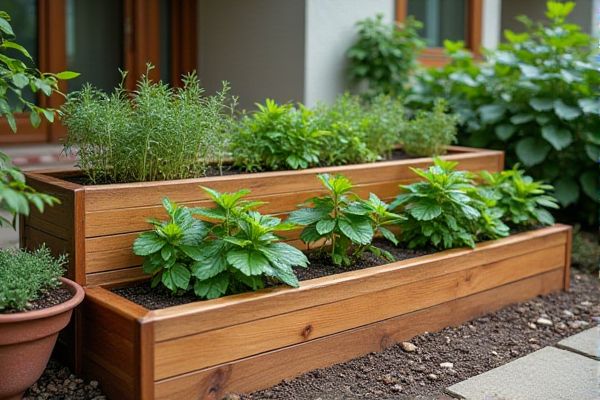
Raised planter boxes provide a fixed, elevated gardening space that improves soil drainage and eases access for planting and maintenance, while stackable planters offer versatility and space-saving benefits by allowing you to customize your garden vertically. Explore the rest of the article to discover which option suits Your gardening needs best.
Table of Comparison
| Feature | Raised Planter Box | Stackable Planter |
|---|---|---|
| Design | Single large container elevated from ground | Compact, modular boxes stacked vertically |
| Space Efficiency | Requires more ground space | Optimizes vertical space, ideal for small areas |
| Soil Depth | Deeper soil for root growth | Shallower soil layers suited for small plants |
| Plant Variety | Supports larger plants and vegetables | Best for herbs, succulents, and small flowers |
| Mobility | Often heavier and less portable | Lightweight, easy to rearrange |
| Assembly | Usually fixed, may require tools | Simple stack-and-lock system |
| Drainage | Better drainage options with raised soil bed | Drainage depends on individual units, may require attention |
| Cost | Generally higher initial cost | More affordable, scalable investment |
| Ideal Users | Home gardeners with ample yard space | Urban gardeners with limited space |
Introduction to Raised Planter Boxes and Stackable Planters
Raised planter boxes offer a sturdy, elevated gardening solution ideal for growing vegetables and flowers with enhanced soil drainage and reduced weed growth. Stackable planters maximize vertical space, perfect for small balconies or patios, allowing you to cultivate multiple plants in a compact area. Choosing between these options depends on your available space and gardening goals.
Key Design Differences
Raised planter boxes feature a fixed, larger structure with ample soil depth for deep-rooted plants, offering enhanced stability and space for extensive gardening. Stackable planters consist of modular, smaller units designed for vertical gardening, maximizing limited space and allowing easy customization or expansion. Your choice depends on available space and the types of plants you intend to grow.
Material Comparison
Raised planter boxes are typically constructed from durable materials like cedar, redwood, or recycled plastic, offering excellent resistance to weather and pests while providing natural insulation for plant roots. Stackable planters often utilize lightweight plastics or resin composites that allow easy modular assembly and portability but may have lower thermal regulation and durability compared to wood. Choosing between these materials depends on balancing long-term durability and environmental exposure with the flexibility and space-saving benefits of stackable designs.
Space Efficiency and Footprint
Raised planter boxes offer a larger footprint ideal for extensive gardening but require more ground space, making them less suitable for limited areas. Stackable planters maximize vertical space, providing high space efficiency by allowing You to grow multiple plants within a minimal surface area. Choosing between them depends on your available space and the desired extent of your garden.
Assembly and Installation
Raised planter boxes typically require more complex assembly involving securing panels and attaching legs or frames, often needing tools such as drills or screwdrivers for installation on a fixed surface. Stackable planters offer simpler installation with modular components that easily snap or slot together, allowing flexible arrangements and minimal tools required. The choice between the two depends on ease of setup preferences and the intended permanence of the planting structure.
Customization and Versatility
Raised planter boxes offer extensive customization options in size, shape, and materials, allowing gardeners to design a personalized growing space tailored to their specific garden layout and plant needs. Stackable planters provide versatility through modular components that can be easily rearranged or expanded vertically, maximizing limited space in urban or small garden environments. Both options enhance gardening flexibility but cater to different preferences for fixed versus adaptable planting solutions.
Maintenance Requirements
Raised planter boxes generally require less frequent maintenance due to their larger soil volume, which retains moisture longer and supports deeper root systems, reducing the need for constant watering and nutrient supplementation. Stackable planters, while space-efficient and ideal for small areas, often need more regular watering and fertilizing because their smaller compartments dry out faster and can limit root growth. Choosing between the two depends on available time for upkeep and the specific plants being grown, with raised beds favoring those who prefer low-maintenance gardening.
Cost and Budget Considerations
Raised planter boxes generally require a higher initial investment due to materials like wood or metal and construction costs, but they offer long-term durability and space for larger plants. Stackable planters tend to be more budget-friendly upfront, with their modular design allowing you to expand your garden incrementally as your budget allows. Your decision depends on whether you prefer a stable, permanent solution or a flexible, cost-accessible option for growing plants.
Best Uses for Each Planter Type
Raised planter boxes are ideal for growing vegetables, herbs, and flowers in backyard gardens where soil quality needs improvement and drainage control is essential. Stackable planters are best suited for small spaces like balconies or patios, allowing vertical gardening of compact plants such as succulents, strawberries, or leafy greens. Choosing between these planters depends on space availability and the type of plants intended for cultivation.
Choosing the Right Planter for Your Garden
Raised planter boxes offer deep soil beds ideal for root vegetables and long-term plant growth, providing excellent drainage and insulation against temperature fluctuations. Stackable planters maximize vertical space, making them perfect for small gardens or balconies, and enable easy customization by adding or removing tiers to suit plant variety and garden size. Selecting between the two depends on available space, plant types, and desired garden layout flexibility.
 homyna.com
homyna.com